 |
|||
| Newsletter Vol. 2 | November 12,2002
|
||
| New Staff Members
Steven Vettese, our webmaster, has just left us for the happy world of matrimony. He recently moved to Atlanta where he will be a physical science teacher and assistant lacrosse coach. He will still assist us remotely through our server on a part-time basis. Although he will be missed, we have 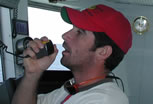 a wonderful new staff member to fill his shoes. Dewey Golub received his
Bachelor’s degree in Marine Biology from the College of Charleston
in 1998. He then moved to British Columbia to live and work with the Hesquit
Indians to rebuild habitats for Salmon spawning. From there he relocated
to Palm Beach Florida where he worked for the Marinelife Center of Juno
Beach. His work there involved Sea Turtle nesting surveys. Eventually,
Dewey went back home to the Boston area to work with an internet start-up
company where he obtained all his technical expertise. When the internet
company didn’t live up to his expectations he became a crew member
aboard private vessels. His travels took him to the Florida Keys, the
Caribbean Ocean and the Mediterranean Sea. This brings us to the present,
where Dewey is the new Educational Technology Specialist (webmaster) for
Project Oceanica. We are very excited to have him and look forward to
working with him.
a wonderful new staff member to fill his shoes. Dewey Golub received his
Bachelor’s degree in Marine Biology from the College of Charleston
in 1998. He then moved to British Columbia to live and work with the Hesquit
Indians to rebuild habitats for Salmon spawning. From there he relocated
to Palm Beach Florida where he worked for the Marinelife Center of Juno
Beach. His work there involved Sea Turtle nesting surveys. Eventually,
Dewey went back home to the Boston area to work with an internet start-up
company where he obtained all his technical expertise. When the internet
company didn’t live up to his expectations he became a crew member
aboard private vessels. His travels took him to the Florida Keys, the
Caribbean Ocean and the Mediterranean Sea. This brings us to the present,
where Dewey is the new Educational Technology Specialist (webmaster) for
Project Oceanica. We are very excited to have him and look forward to
working with him. 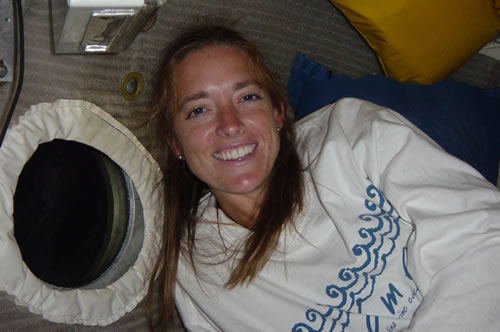 Lisa Hollen is our newest staff member. She participated on the “Islands in the Stream 2002: Exploring Underwater Oases” Expedition. Lisa is involved with the comparison of rocks and sediments along the edge of the continental shelf from northern Florida to northern South Carolina. She will examine the fossil assemblages in the sediments and study the benthic invertebrate communities that inhabit the "live rocks." |
|||
| Congratulations Dr. Leslie Sautter is the Director of Project Oceanica and an Associate Professor of Geology at the College of Charleston. She received the Marine Education Award from the National Marine Educators Association for 2002. This award is given for outstanding work in marine education at the local or national level. She received a plaque and a one year membership to NMEA at the annual conference in July, 2002. Leslie was also South Carolina Marine Educators Association’s Educator of the Year for 2001. Way to go, Les!! |
|||
| Undersea
Opportunity The second Islands in the Stream Expedition took place this summer, and Oceanica’s Leslie Sautter and Lisa Hollen were participating scientists on Leg 001 of the expedition. This expedition, named “Exploring Underwater Oases,” was funded by the NOAA Office of Ocean Exploration, 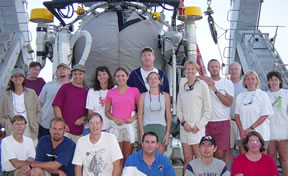 and was lead by Chief Scientist, Dr. George Sedberry of the SC
Dept. of Natural Resources . One of Oceanica’s roles in the
expedition is to translate scientific discoveries and information for
use in developing educational materials. The purpose of the expedition
was to explore high-relief areas along the continental shelf edge and
upper slope along the eastern coast of Florida to North Carolina within
an area known as the South Atlantic Bight. They spent 10 days aboard
Harbor Branch Oceanographic Institute’s Research Vessel Seward
Johnson. They were able to examine bottom habitats with the use of Harbor
Branch’s Johnson Sea-Link II submersible. The submersible enabled
them to collect video and photographic images of shelf-edge reef habitats
as well as samples of sediment, rocks, and marine organisms. Leslie
and Lisa will examine the sediment samples to determine the community
of benthic foraminifera, (single celled, bottom dwelling Protists),
for comparison with fossil assemblages of both benthic and planktonic
foraminifera. Please visit Ocean
Explorer, Project Oceanica and the Underwater Oasis Expedition on
the Project Oceanica website.
and was lead by Chief Scientist, Dr. George Sedberry of the SC
Dept. of Natural Resources . One of Oceanica’s roles in the
expedition is to translate scientific discoveries and information for
use in developing educational materials. The purpose of the expedition
was to explore high-relief areas along the continental shelf edge and
upper slope along the eastern coast of Florida to North Carolina within
an area known as the South Atlantic Bight. They spent 10 days aboard
Harbor Branch Oceanographic Institute’s Research Vessel Seward
Johnson. They were able to examine bottom habitats with the use of Harbor
Branch’s Johnson Sea-Link II submersible. The submersible enabled
them to collect video and photographic images of shelf-edge reef habitats
as well as samples of sediment, rocks, and marine organisms. Leslie
and Lisa will examine the sediment samples to determine the community
of benthic foraminifera, (single celled, bottom dwelling Protists),
for comparison with fossil assemblages of both benthic and planktonic
foraminifera. Please visit Ocean
Explorer, Project Oceanica and the Underwater Oasis Expedition on
the Project Oceanica website. |
|||
| What Has the Staff Been Up
To? |
|||
| A Great Way to Start the School Year NOAA’s Office of Ocean Exploration hosted an ocean front festival on August 17th in Charleston, SC to highlight their current expedition “Islands in the Stream 2002: Exploring Underwater Oases.” Over 250 school children from grades 5-12 attended the festival with their classes. Oceanica was one of the featured exhibitors as were the S.C. Aquarium, S.C. Dept. of Natural Resources, S.C. Phytoplankton Monitoring Network, Gray’s Reef Marine Sanctuary and many others. All the exhibitors had hands-on activities for the students and lots of fun, free “stuff.” In addition to the exhibits, the main event of the festival was the opportunity to board two huge research vessels! The students were treated to guided tours of the NOAA Ship RON BROWN and of course the expedition ship itself, Harbor Branch Oceanographic Institute’s R/V Seward Johnson. The Seward Johnson houses the submersible Johnson Sea-Link, which was used in the expedition to explore the underwater oases and collect samples of animals, rocks, sediment and plant-life. |
|||
| Oceanica Initiates After-School Marine Science Enrichment Programs Project Oceanica is pleased to announce the completion of the pilot program
"Marine Magic," developed by South Carolina certified teacher
James (Jim) Reed. This six-week after-school program explored several
marine topics such as the relationship between Earth's moon and the
tides, density and density driven currents, and how natural selection
in a changing environment can be modeled in the classroom. All activities
were conducted in class and projects were taken home by the students,
and were re/de -constructed as well as communicated to others.
|
|||
| Current Projects Rachel McEvers and Leslie contributed two lesson plans for NOAA’s Ocean Exploration “Islands in the Stream 2002: Exploring Underwater Oases” Expedition. The purpose of the expedition was to gather more information on the hardbottom communities in the South Atlantic Bight region. The lesson plans focus on the differences in seafloor sediments and the bathymetry of the continental margin in the South Atlantic Bight. You can access the Expedition information (and the lesson plans) at http://oceanexplorer.noaa.gov . Dewey and Rachel sailed aboard the NASA vessel M/V Liberty Star for a 9-day research cruise. 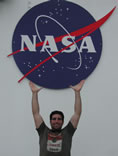 The
co-Principal Investigator of the cruise was Andrew Shepard from The NOAA
National Undersea Research Center
at University of North Carolina, Wilmington. They left from the Cape Canaveral
and cruised a 40-mile long transect parallel to the Florida shore. The
purpose of the cruise was to map and characterize habitat condition in
and near the Oculina Banks coral reef habitat, with an emphasis on those
areas that support live Oculina reefs. This was done with multi-beam and
side-scan sonar systems attached to the hull. The Oculina Banks is the
oldest marine protected area off the southeast coast and this mission
will help scientists determine whether or not their conservation efforts
have been successful. You can read the daily logs from the cruise on the
Oceanica website http://oceanica.cofc.edu/oculina
. The
co-Principal Investigator of the cruise was Andrew Shepard from The NOAA
National Undersea Research Center
at University of North Carolina, Wilmington. They left from the Cape Canaveral
and cruised a 40-mile long transect parallel to the Florida shore. The
purpose of the cruise was to map and characterize habitat condition in
and near the Oculina Banks coral reef habitat, with an emphasis on those
areas that support live Oculina reefs. This was done with multi-beam and
side-scan sonar systems attached to the hull. The Oculina Banks is the
oldest marine protected area off the southeast coast and this mission
will help scientists determine whether or not their conservation efforts
have been successful. You can read the daily logs from the cruise on the
Oceanica website http://oceanica.cofc.edu/oculina
. |
|||
| LOST and FOUND! Dewey proved himself as our new webmaster. Somehow we "lost" Steven Vettese's wonderful Folly Beach educator's guide in cyber space. It is now the first link on Oceanica's Lab and Field Activities Page (within the Resource Products section) -- the URL is http://oceanica.cofc.edu/activities.htm This is a great guide, check it out!! |
|||
| Port Fest 2002 Port Fest 2002 started on September 29 in Charleston, SC. Rachel coordinated the exhibitors for week 4, “Living Waterfront”. The Charleston Maritime Center and the Maritime Association of the Port of Charleston hosted this weekly ocean front event to introduce the Charleston public to the various waterfront and waterborne entities in Charleston Harbor. “The Living Waterfront” was the theme for week 4 on October 20. The survey NOAA Ship FERREL was dockside. In addition, the Charleston Explorer, a touring pontoon boat, ran cruises to Morris Island for a uniquely lowcountry ecological experience. |
|||
Catch the
Spirit! The building of the Tall Ship Spirit of South Carolina has started and there is a place for you! The  project
is underway and they are welcoming volunteers to become involved. They
have opportunities for a variety of interests. Anyone interested in
volunteering should contact Janet Segal at jsegal@scmaritime.org
or 843-722-1030 or 843-722-3787. For more information contact The
South Carolina Maritime Heritage Foundation. project
is underway and they are welcoming volunteers to become involved. They
have opportunities for a variety of interests. Anyone interested in
volunteering should contact Janet Segal at jsegal@scmaritime.org
or 843-722-1030 or 843-722-3787. For more information contact The
South Carolina Maritime Heritage Foundation.A group of very special volunteers is working to create the very first Maritime History Museum, which will be housed at the Shipyard. These volunteers are researching, writing and planning the exhibits. They would love YOUR help! If you want to work from home, do research and locate artifacts, and plan educational opportunities, this group has a place for you. The museum will open this fall, so this requires some fast work. The Shipyard will be open 7 days a week. Volunteers are needed to work morning and afternoon shifts doing a variety of tasks. These opportunities include concession/gift sales, ticket sales, docents, museum docents, general labor, greeters and sidewalk marketers and vessel construction (this requires woodworking/shipbuilding skills and permission of Shipwright). You will be outdoors, have a special volunteer uniform, and there's even free parking! Come to an Orientation Session to find out more! Help is also needed in the office. Data input (needed right now), fund raising, clerical work and help on events (needed now and October) are some of the opportunities available.All volunteers are required to attend a 1.5 hour Orientation Session and commit a minimum of two 4-hour shifts per month. If you are interested in joining, come to the following Orientation Session (if you can't make it, there will be others scheduled.) Orientation Session Wednesday, December 11 These session are at 6:00 PM Spirit of SC Shipyard - Ansonborough Field, corner of Calhoun and Concord - across from the Maritime Center. RSVP with your name and which session you will attend jsegal@scmaritime.org. Be part of the fun and part of a most exciting project; it's a chance of a lifetime-Don't miss out! And tell your friends, relatives, co-workers and neighbors about The Spirit of SC and the opportunity for volunteering. Also, they are always looking for business sponsors and donors to support the building of this very special ship. |
|||
| At Sea! Program Update In order to increase the number of high schools able to participate in the At Sea! program, we have changed our criteria for participant selection and our format for the cruises themselves. Last year we took one entire high school class per At Sea! cruise. This year, we are using a team approach. For each cruise, four teams participate, where each team consists of one high school teacher, three high school students and two undergraduate students from the College of 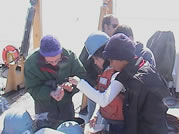 Charleston. This means we can take teams from four different high schools
on each cruise. The teachers themselves develop their selection criteria
for selecting their team members. The purpose of the undergraduate student
involvement is to have mentors within the team who will help to coordinate
the post-cruise data analysis and creation of the presentation. We have
recently completed an instructor’s resource guide for At Sea!. It
provides participating teachers all the information they need for a smooth
and enjoyable At Sea! experience for them and their students.
Charleston. This means we can take teams from four different high schools
on each cruise. The teachers themselves develop their selection criteria
for selecting their team members. The purpose of the undergraduate student
involvement is to have mentors within the team who will help to coordinate
the post-cruise data analysis and creation of the presentation. We have
recently completed an instructor’s resource guide for At Sea!. It
provides participating teachers all the information they need for a smooth
and enjoyable At Sea! experience for them and their students.
We are most grateful to the captain (Lt. Commander Jim Meigs) and crew of the NOAA Ship FERREL for all their dedicated work toward making the At Sea! program a success. Sadly, the FERREL is scheduled for decommission in December. We hated to say goodbye to her (Leslie has sailed with the FERREL for 8 years!), and we will very much miss working her crew. Participants of the Fall 2002 At Sea! Field Season: The 9 high schools that participated in the Fall 2002 field season
were West Ashley, Wando, Hannahan, Burke, North Charleston, Porter-Gaud,
Ashley Hall, James Island, and James Island Christian School. |
|||
| COASTeam Update Project Inquiry, a National Science Foundation grant to Charleston and Berkeley County School Districts, sponsored the "Middle School Science Standards Institute: COASTeam" June 3-June 8, 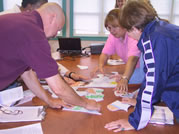 2002.
26 teachers from the Charleston and Berkeley County School Districts participated
in the course. 2002.
26 teachers from the Charleston and Berkeley County School Districts participated
in the course.Educate Colleton Outdoors, a Gaylord and Dorothy Donnelly Foundation grant awarded to the Department of Natural Resources, sponsored a "Middle School Marine Science" course June 18-June 26. The course was held at the Bennett's Point facility in the ACE Basin and 7 teachers from Colleton County participated. Jennifer Jolly Clair attended the National Marine Educators' Association's annual conference in New London, CT July 19-July 26. She presented "The COASTeam Program: a model for teaching teachers interdisciplinary science" to a group of approximately 15 educators from across the country. Jennifer Jolly Clair, Stephen Schabel, Katrina Bryan, Stacia Fletcher, Kevin Kurtz, and Carmelina Livingston are busy developing the curriculum for the grade-specific COASTeam Aquatic Workshops for Kindergarten-5th grade teachers. Each grade level focuses on a specific South Carolina region and integrates marine science concepts and exhibits at the SC Aquarium. The Kindergarten, First and Second Grade Aquatic Workshops will be held during the 2002-2003 school year; with the Third, Fourth and Fifth Grade Workshops planned for the 2003-2004 school year. The COASTeam Program is currently recruiting interested schools to participate in the pilot Aquatic Workshops. To find out more about COASTeam visit http://oceanica.cofc.edu/coasteam. |
|||
| WHEW! You don’t realize how busy you are until you write it all down. It’s great! Oceanica is growing by leaps and bounds. Dewey has his hands full trying to keep the website updated with all our new projects and products. The website is constantly changing so make sure to visit often - http://oceanica.cofc.edu . If you want more information on any of our projects don’t hesitate to contact us at oceanica@cofc.edu . Thank you so much for your support and interest and be on the look-out for more Oceanica news in the near future. |
|||
|
Director: Leslie Sautter |
|||